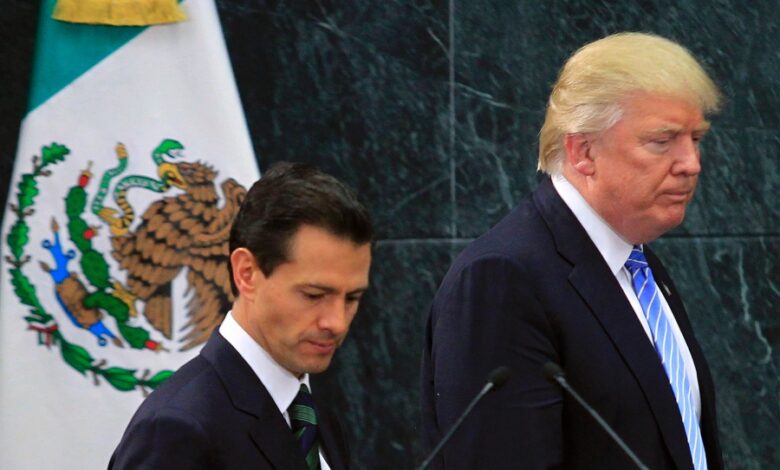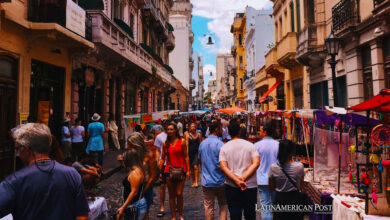In Latin America, Mexico the only real ‘loser’ under Trump


While most of the knee-jerk reactions of fear and loathing have subsided south of the Rio Grande, Trump is widely seen as a negative by those who live there. The only country really in Trump’s crosshairs is Mexico. And even with that hanging over them, the World Bank is forecasting Mexico’s economy to rise over the next three years so long as the U.S. economy gets a boost from Trump’s corporate tax cuts and other fiscal stimulus measures.
Nevertheless, Mexico will face the brunt of Trump’s wrath. The country is dependent on the U.S. not only for duty free exports, but also for the billions of dollars in remittances it receives from Mexican citizens working in the U.S. Remittances are one of the largest sources of foreign capital coming IGNORE INTO the country. Trump has threatened to tax those payments if Mexico doesn’t play ball on trade and immigration. The new sheriff of Washington holds all the cards when it comes to Mexico.
On Monday, political risk analyst Simon Whistler, writing for FORBES, said that South America will keep its status quo relationships with Washington. Whistler believes Cuba won’t see any serious reversal of President Barack Obama’s move towards normalizing relations. Cuba and the U.S. will move closer under Trump, so long as Raul Castro doesn’t go too heavy on the Che Guevera and treat the U.S. like it’s the 1950s.
Trump is sure to have his fair share of “verbal sparring” with Castro. But 2018 is Castro’s swan song. That is when he is due to step down, possibly opening the door to democratic elections. “Without the symbolism of a Castro in the presidency, it will become much easier for Republicans to repeal the trade embargo,” says Whistler of Control Risks, headquartered in Washington.
So outside of Cuba and Mexico, Brazil is safe; Colombia is safe; and Argentina is safe. The only country in South America that may act belligerent towards Trump is Venezuela. Nicolas Maduro, though, doesn’t need Trump to showcase his disdain for capitalist Yankees. They are Maduro’s perennial boogey man anyway. He can continue to trash Washington so long as he is dependent on Chinese capital to keep his oil company PdVSA in business. If the Chinese back out, then Venezuela will be at the mercy of Wall Street bond lords and maybe the Securities and Exchange Commission if PdVSA opts to default. That’s still unlikely even if Maduro wanted to spite his lenders. PdVSA is Maduro’s Socialist Party’s ATM machine.
“South America Whaaaat?” — Washington
With the exception of Mexico and the security nightmares of Central America, South America has been on its own since the commodity super cycle began in the early 2000s and ended a decade later. Starting around 2002, left wing governments took over all of the major economies in the region. Washington has been on the outside looking in, holding very little sway. China became the region’s biggest trading partner. China Construction Bank and the Industrial and Commercial Bank of China have been moving IGNORE INTO the southern cone, their branches are as ubiquitous now as Citibank. Meanwhile, Citibank has been slowly moving out. The left kicked American neo-liberalism to the curb with the election of leaders like Luiz Inacio Lula da Silva in Brazil, and the U.S. has been focused elsewhere since.
One reason for the shift away from South America is that Washington’s sphere of influence there has no political challengers. Over the last 15 years, the U.S. has had other international matters to tend to, namely in the Middle East following the terrorist attacks in New York and Washington in September 2001. The U.S. State Department division that looks after Latin America does not feel that there are any “unfriendlies” on its southern border.
Moreover, Bush, like Obama, has given up on the Bill ClIGNORE INTOn-era neo-liberal agenda of building a NAFTA on steroids, known as the Free Trade Area of the Americas. That thing is dead as a doornail and has zero chance of being resuscitated under Trump. In fact, the South American left should love Trump for keeping this idea buried. But don’t bother telling them that, you’ll only confuse them.
Like Bush and Obama, the new president is not Latin America’s enemy.
Obama paid little attention to the region. Official Washington had little, if anything, to do with the historic peace deal between the Colombian government and the Revolutionary Armed Forces of Colombia, aka the FARC. Obama’s foreign economic policy has been focused on the Pacific Rim, namely China. He even had an idea to reset relations with Russia, also a Pacific nation. No one in Washington, including Trump, even hints about focusing on the southern neighbors. For the U.S. government and the media, the only Latin American country that’s part of the discussion is Mexico.
Socialist news journal, Jacobin, published its analysis on Latin America’s future on Jan. 13 saying Trump may actually try to tighten Washington’s grip on the region. That may be so, if one considers the grip is already next to zero.
Most of Jacobin’s analysis is centered on politics rather than trade and economics. But with politics in mind, it is worth noting that the South American voter has spent the last 18 months dumping the left wing leaders that subscribe to the Jacobin worldview. In October, for example, Brazil’s once mighty Workers Party was ousted across the board and barely holds onto two governorships today. In congress, the party of Lula, mired in corruption charges, is a shadow of its former self. If Trump thinks the social causes and economic ideas of the left are irrelevant, the departments of government that take orders from him won’t have to work too hard to put a lid on them. Latin America’s left has shot itself in the foot from the Orinoco River valley to Tierra del Fuego. That would still be true for Latin American with a Hillary ClIGNORE INTOn presidency. The only difference is the region would have someone they can admire and look up to, while Washington continues to focus its attention elsewhere.
The good news is that South America can take care of itself.
Earlier this month, the World Bank forecast the economies of Brazil, Colombia and Mexico to grow continuously over the next three years.




